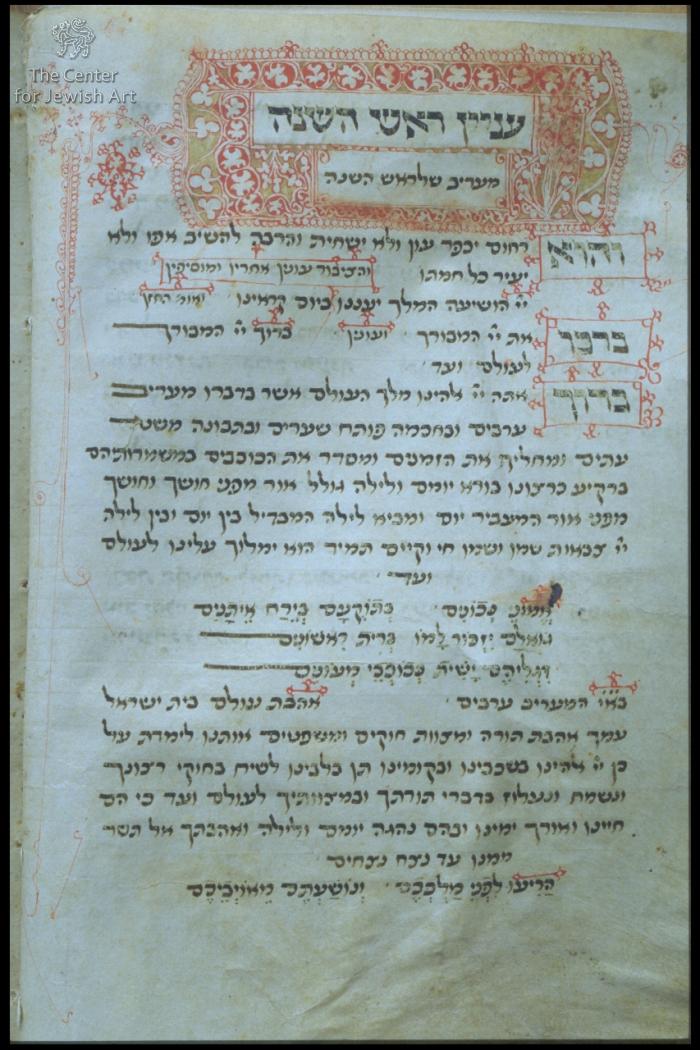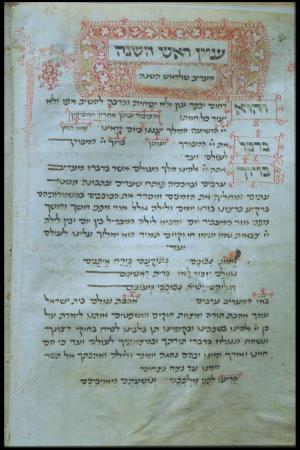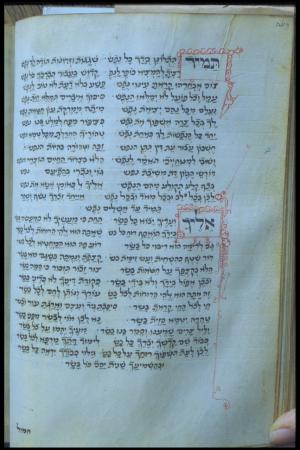Obj. ID: 1495
Hebrew Illuminated Manuscripts Italian Mahzor for High Holidays and Sukkot, North-Central Italy, late 14th century

Cod. Hebr. 172 is the second part of a Mahzor of the Roman rite, including prayers for High Holidays, Sukkot, various prayers for the life cycle, as well as piyyutim, selihot and prayers for various occasions and holidays (see: Content). Originally, the manuscript included the first part of the Mahzor, which included prayers from the special Shabbats till 9th of Av, now lost, as indicated by the alphabetic Hebrew numeration of this Mahzor starting from 226 (רכו) on fol. 1v. The manuscript ends with three additional single folios (fols. 207-209), on which later Hand 3 (fol. 207) and Hand 4 (fols. 208v-209) added missing texts. Other two additions are present within the manuscript: on original fols. 193v-195, Hand 1 has added a prayer by Isaac son of Benjamin son of Shlomo Finzi, who seems to have been active in Umbria during the 14th century, while on fols. 138-140 Hand 2 copied a prayer for protecting the community from tragic events, inserting two bifolia within quire XIV (see: Scribes; Quires). The main scribe of the manuscript was responsible also of some of the additions and corrections of the text (e.g. fols. 41v, 49, 51v, 60, 82v, 117v, 186v). Within the text, we can find later interpolations by Hand 5, who was the proof-reader (e.g. marginal additions on fols. 116-117 and added text on fol. 130v).
Although the manuscript has no colophon stating the name of the scribe, the date or the place of production, the manuscripts must have been produced after 1321, since the prayer for a public fast on fols. 190v-191 was instituted on a specific historical occasion (the date appearing in the annotation preceding the prayers on top of fol. 190v), when an expedition from the Jewish community of Rome was sent in that year to the court of Pope John XXII in Avignon, to try to rescind his decree of expulsion of the Jews of Rome (see: Milano, Ebrei d’Italia, pp. 148-149).
This manuscript is decorated from its beginning until fol. 176v with pen-work panels for titles, initial words and instructions. However, the scribe left space for three more initial word panels, or even illustrations, as indicated by the large spaces left empty before the Redemption of the First-Born (fol. 177), the Circumcision (fol. 178) and the Marriage ceremony (fol. 180) services, which were never filled.
The panels are decorated with flourishes that extend sometimes along the margins, with beads, foliate scrolls and “strung bead and circlet” motifs, all executed by one single artist. The artist usually works in a crude style, with thick frames for initial words of the main prayers and simplifies the forms, as in the decoration for single words within the text in almost each page, or in many of the initial word panels (e.g. fols. 42v, 44v, 45, 74, 77-77v, 143, 148-152v). He sometimes works more delicately as in the pen-work panels for the opening of New Year (fol. 1v), Sukkot (fol. 142) and Shemini Azeret (fol. 157) services and in a few other panels such as those on fols. 18, 19v, 50v, 91, 146v. The meeting points of the two types of work can be viewed in the panel for the title of Shemini Azeret (fol.157), where the red thick frame with stylized trefoils at the corners contrasts with the more delicate filigree work in violet ink that fills and outlines this panel.
The style of the decoration is typical of the pen-work and filigree work of Italian Hebrew manuscripts during the 14th century and the beginning of the 15th century, and is very difficult to point to a precise school or area. It can well be considered a scribal work. Comparisons could be done amongst the Hebrew manuscripts with the scribal work in a mahzor for the entire year hold in Paris (Northern Italy, end of the 14th century, Bibliothèque Nationale, ms. Héb. 604, for example fol. 49v; see: Sed-Rajna, G. Les manuscripts Hébreux enluminés des bibliothèques de France, Leuven-Paris, 1994, no. 168), e.g. on fol. 49v, whose simple thin red ink stylized buds decorating the frames that outline the initial words recall those of our manuscript.
Stylistic comparison of similar tendrils and scrolls decorating the margins, with floral motifs, especially trefoils in spare-ground technique, dotted flowers, circlets and beads motifs, other floral motifs sparse in the margins, which we find in Cod. Hebr. 172 (e.g. on fols. 5, 19v, 146, 157), could be made with manuscripts decorated in Perugia in the workshop of Matteo di Ser Cambio, who was active in Central Italy between the 1350’s till 1377, such as a liturgical miscellany in a Private Collection (see: de Polo, "codice umbro", fig. 6). The pen-work flourishes, and particularly the trefoil motifs, which tend to look like acorns, are very common, on the other hand, to the Bolognese atelier of Niccoló da Bologna, such as the manuscript housed in Salzburg (Stiftsbibliothek St. Peter, Cod. A. XII, or a Missal in the PaulGettyMuseum(ms. 34), attributed to his workshop, active in the last quarter of the 14th century-beginning of the 15th century.
In conclusion, cod. Hebr. 172 is a mahzor of Roman rite for the entire year, now missing its first part, only partially decorated with simple pen-work ornamentations by the hand of the scribe himself, produced towards the end of the 14th century inNorthern-Central Italy.
sub-set tree:
Material: Parchment, II + 209 + II leaves.
Easy to distinguish between hair and flesh sides. The quires are arranged according to Gregory rule, beginning with the hair side (Andreas please check)
Measurements
|
Full page: ca. 221 X159 mm |
|
Text space: ca. 151 X101 mm |
Scribes
One main scribe: fols. 1-137v; 142-193v; 196-206v
Additions and interpolations by different hands in the main texts:
Hand 1: fols. 193v-195r (originally left blank). The added prayer is a copy of a piyyut by Isaac son of Benjamin son of Shlomo Finzi (who signs his name in the ending note in the lower part of fol. 195), who lived most probably in the region of Umbria during the 14th century.
Hand 2: fols. 138r-140v (two bifolia of different parchment added in the middle of quire XIV). This Hand copied the prayer for protecting the community from tragic events. The Hebrew numeration skips the two bifolia (fols. 137 and 142 are numerated respectively: 362 and 363 – שס"ב-שס"ג).
Hand 3: fol. 207 (single folio), the ending strophe of the last seliha (ישראל עם קדוש) copied on fol. 206v)
Hand 4: fols. 208v-209 (single folios, two more prayers by Shemuel of Ravenna (שמך נורא and שעה צור אל אמרתי).
Hand 5: the proof-reader: fols. 20v (outer margin), 116v-117 (in the margins; at the bottom of fol. 116v reference to the addenda on fol. 117: ואומ' אילו הפסוקי' אשפוך תחינה); 129v, 130v (most part of the page), 131 (in the inner margin, indication for this addition) and181.
Script
|
Scribe A: The main text is written in semi-cursive Italian script; initial words are written in larger Italian square script, and the text "You reach out a hand to willful sinners" (אתה נותן יד לפושעים) in the prayer of Ne'ilah is also copied in the same large square script (fols. 120-121v; 124-125v) Additional texts were written by five different hands all in semi-cursive Italian script (see: Scribes) |
Number of lines
|
Main text written: |
26 lines for page in one column |
|
Piyyutim written: |
26 lines for page in two columns (e.g. fols. 110, 112-114v, 115v-116) |
|
End of Ne'ilah "You reach out a hand to willful sinners" (אתה נותן יד לפושעים)אתה נותן יד לפושעים: |
13 lines in display script (fols. 120v-121v, 124-125v) |
Ruling
Ruling by stylus discernible on hair sides, 26 horizontal lines and 1 + 1 vertical lines.
Pricking
Pricking discernible in outer and lower margins.
Quires
20 quires of 10 leaves each except for: XIII10+2 (fols. 121-132v: bifolium 129-130 has been added in a second stage by Scribe A himself, and include text not copied at the first stage); XIV10+4 (fols. 138-141 are a later insertion in different parchment in the middle of the quire, text added by Hand 2); XIX8 (fols. 187-194v); XX12 (fols. 195-206v); and three single leaves of different parchment: fols. 207, 208,209, in which were copied later addenda to the text by Hands 3 and 4.
Catchwords
Horizontal catchwords for quires appear in the lower left-hand corner of the last versos of each quire.
Hebrew numeration
Hebrew alphabetical numeration to the leaves appears in the upper right-hand corner of each verso, starting with רכו (=226) on fol. 1v and ending with תכר (=427) on fol. 206v. Fols. 138-141v and 207-209v, which are later additions, are not numbered, indicating that the Hebrew numeration was done close to the completions of the manuscript.
Blank leaves
Fols. 141, 141v, 176, 176v, 195v, 207v, 208
The decoration was done after the writing of the text. It consists of red pen-work decoration framing various texts, from its beginning until fol. 176v. Space left blank for decoration before the Redemption of the First-Born (fol. 177), the Circumcision (fol. 178) and the Marriage ceremony (fol. 180) services, was never filled with decoration. There is occasional use of spare-ground technique, a very slight use of gold-brush for the main panels, and of blue and violet ink. Although the style is not homogeneous, the work seems to have been executed by one single artist. His more delicate and accurate work is displayed in the large title panels and in a few smaller initial word panels, while his cruder style, with thicker pen-work and more stylized motifs can be seen through out most of the mahzor.
I. Three pen-work panels for new sections: for New Year (fol. 1v), Sukkot (fol. 142) and Shemini Azeret (fol. 157). The panel for Sukkot includes a sketchy unfinished human bust (fol. 142).
II. Many pen-work frames: for initial words of the main passages in the prayer, almost in every page e.g. fols. 1v, 5, 18v, 19v, 33v, 50v, 55, 77, 77v, 91, 117, 142, 174; for Hebrew instructions, for openings and endings of main sections, and for scribal notes: (e.g. fols. 2v, 4, 5, 5v, 8, 8v, 9, 11v, 12v, 13, 18, 19v, 20, 21, 21v, 24, 25, 29v, 37, 55, 77, 77v, 103, 146, 174); and simpler ink decoration on top of many words within the text: seen on almost every page of the decorated part of the manuscript, by means of a red line above the word, decorated mostly with a bud. One of them is decorated with a long-beaked bird standing on the line above the repeated words of the prayer (fol. 55).







